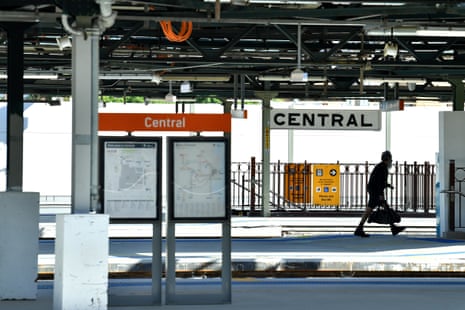Public transport use continues to lag across Sydney and trips to city offices and entertainment venues remain low, with average daily weekday trips still down 55% on pre-pandemic levels.
Trips rose just 1% between February and March, despite the indoor mask mandate – which had been attributed as a leading cause of the sluggish return to offices – dropping more than a month ago.
Google movement data also shows that visits to entertainment and retail venues were still more than 15% down on pre-pandemic levels, and still lagging by almost 20% at workplaces.
A spokesperson from the Transport for NSW said the recent wild weather and floods had disrupted the return.
Whether the city will ever get back to the pre-pandemic hustle and bustle remains a live question, with more workplaces offering hybrid working models.
Chief economist at the University of Technology Sydney, Prof Tim Harcourt, said the way we operate had changed fundamentally over the past two years and that going into the city every day might not be needed for everyone now.
“It was a reset of whatever we were doing before,” Harcourt said.
“Covid, not that I would want to have it again, gave us a bit of a window into how we could make a change [in how we work] – it accelerated the transition.”
Average daily weekday trips across Sydney’s public transport amid the Omicron wave numbered 725,000 for January – down 63% on 2019 figures.
The numbers rose and then plateaued over February and March, reaching about 1m a day, which is 56% lower than pre-Covid levels.
Despite the slow start to the year, the mayor of Sydney, Clover Moore, was confident the city would rebound due to “strong, pent-up demand” and the draw to see others face-to-face.
“We are working to draw people back to the city and creating spaces for businesses to operate safely,” Moore said.
“Almost as soon as Covid lockdowns were introduced, the doomsayers were predicting the death of the city, but I’m hopeful this has been overstated.
“What Covid has done is accelerate trends that were already occurring, including technological change and the changing nature of work. But economic clusters like technology, finance, media and entertainment … thrive on proximity to one another and remain focused here in our city.”
But Harcourt said it would take major initiatives like on-site childcare at big companies to draw people back in, and that it needed to be more than “froth and bubble” gimmicks.
“If they start doing major things, that might have some impact,” he said.
“I don’t think office table tennis is going to cut it.”
A recent Accenture study of thousands of employees from around the world found 83% wanted a hybrid working model.
Harcourt said workplace flexibility would be a selling point for some employers.
